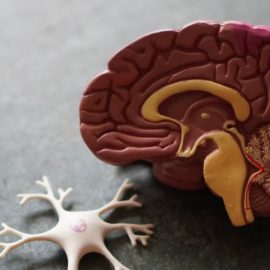

This article is an excerpt from the Shortform book guide to "Come As You Are" by Emily Nagoski. Shortform has the world's best summaries and analyses of books you should be reading.
Like this article? Sign up for a free trial here .
What happens in your brain during an orgasm? Does the brain even register orgasms?
There is a common misconception that orgasms are primarily a genital response. In reality, orgasms are really about what happens inside the brain.
Keep reading to learn about your brain and orgasms.
Our Brains During Orgasm
By using fMRI and PET scans to measure the blood flow and neuron activity of individuals experiencing orgasm, scientists have been able to observe what happens in the brain during this climactic experience.
First, multiple remote brain regions activate during orgasm, including the genital sensory cortex, motor areas, hypothalamus, thalamus, and substantia nigra. Specifically, the genital sensory cortex registers sensation in the genitals, the motor areas govern the body’s movement, the hypothalamus and substantia nigra produce hormones, and the thalamus helps bring together information related to senses, movement, memories, or fantasies that might be useful in reaching orgasm.
Additionally, the lateral orbitofrontal cortex, which is the part of the brain responsible for reason, decision making, and value judgments, becomes less active. Scientists say that one reason for this is to decrease fear and anxiety, which inhibit sexual response.
During an orgasm, the brain also releases a variety of hormones and neurochemicals that promote enjoyment, bonding, pain reduction, and relaxation, such as dopamine, oxytocin, serotonin, endorphins, and vasopressin. This is why we experience things like intense pleasure, closeness with our partner, lower sensitivity to pain, and a sense of calm after sex.
How Our Brains Process Expectations vs. Reality
However, in more specific terms, Nagoski says that orgasm difficulties arise from the way our brains process the gap between our expectations and reality, which our culture’s tendency to set the bar unreasonably high worsens.
Nagoski explains that our brains constantly evaluate our surroundings, making comparisons between the expectations we’ve developed based on our experiences and what’s actually happening. When our expectations don’t match up with reality, we try to close the gap by setting a goal to bring them back into alignment. Nagoski adds that when we think we’re making good progress toward that goal, we remain happy and motivated. But when we don’t see good progress, we become frustrated and increasingly desperate to close the gap, until we eventually give up in despair.
In the case of orgasms, the process Nagoski describes looks like this: Society has given you the expectation that you should be able to have an orgasm from vaginal penetration, but you find yourself unable to do so. Your brain notices this gap between your expectation and reality, and so you become determined to “fix” reality by continuing to try to have an orgasm this way. When it doesn’t work, you become increasingly anxious, which activates the SIS. Ultimately, this makes trying to have an orgasm even more difficult than before, creating a continuous cycle of frustration and anxiety that eventually ends with you giving up on having one altogether.
| How Our Expectations Influence Our Judgments In her discussion of how our brain compares our present surroundings to our set of expectations, Nagoski doesn’t go into detail about exactly how this process works. However, learning more about how our brain processes information can enhance our understanding of how we interpret what’s happening to us, including our experience of sex. Over time, we come to develop many different expectations based on a wide range of experiences. Exactly which expectations we use to judge a given situation, however, depends on many different factors. One of these factors is that we tend to base our judgments on the stored information that’s most accessible to us. What’s most accessible at any given time is determined both by what’s important to us as individuals and by what we’ve been recently or frequently exposed to. Unfortunately, because certain information comes to mind more easily than anything else, it has the potential to influence our judgment—even when it’s counterfactual. We can imagine, then, how this bias may affect our sexual experience. If society constantly tells us that we should be able to have an orgasm from vaginal penetration, that information will become more accessible. Furthermore, because our brain is wired to privilege accessible information, we’re likely to convince ourselves that we should be able to have this type of orgasm, regardless of what the truth may be. And ultimately, we’ll become frustrated and blame ourselves when it doesn’t work out in the way we expected—all because of our brain’s inherent bias. This leads to the type of negative feelings that activate our SIS and inhibit orgasm, making it even less likely we’ll live up to society’s expectations. |

———End of Preview———
Like what you just read? Read the rest of the world's best book summary and analysis of Emily Nagoski's "Come As You Are" at Shortform .
Here's what you'll find in our full Come As You Are summary :
- Why women should change the way they talk, think, and feel about their sexuality
- A look at the misinformation and harmful cultural messaging surrounding sex
- A discussion around the individual experiences of arousal, desire, and orgasm






